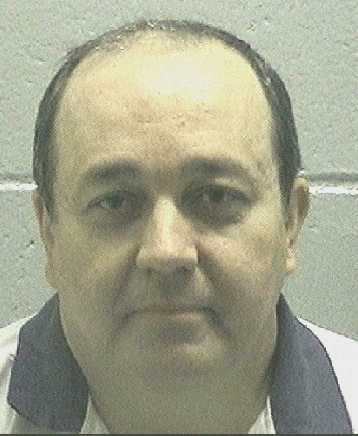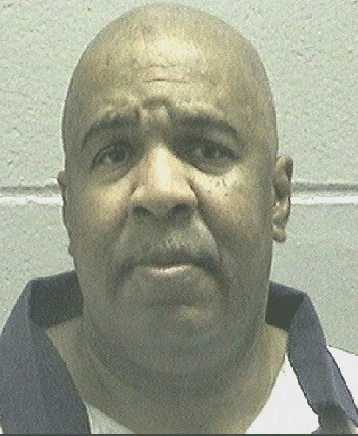
David Franks was sentenced to death by the State of Georgia for three murders. According to court documents David Franks would shoot and kill two people inside of a pawn shop. David Franks would drive to the victims home and would force the next victim to reveal a hidden a safe, Franks would fatally stab the victim. David Franks would be arrested, convicted and sentenced to death.
David Franks 2021 Information
YOB: 1961
RACE: WHITE
GENDER: MALE
HEIGHT: 6’00”
WEIGHT: 240
EYE COLOR: BROWN
HAIR COLOR: BROWN
MAJOR OFFENSE: MURDER
MOST RECENT INSTITUTION: GA DIAG CLASS PRISON
MAX POSSIBLE RELEASE DATE: DEATH
David Franks More News
The evidence at trial showed that David Franks was an acquaintance and occasional business associate of Clinton Wilson, the husband of the murder victim. On the morning of August 5, 1994, Clinton Wilson and David Martin visited Franks’s pawn shop in Haralson County. The next day, Wilson and Martin were found shot to death on the bottom floor of Franks’s pawn shop.2 They had been shot with a nine-millimeter pistol. The medical examiner testified that the upward trajectory of the bullet wounds in the bodies was consistent with the two victims being shot from behind while lying face-down.
After killing Martin and Wilson, David Franks took Wilson’s white “cube” van and drove to Hall County to Wilson’s house, where Franks believed that Wilson had secretly hidden tens of thousands of dollars. The Wilsons’ nine-year-old daughter Jessica answered the door and invited Franks into the home. Franks told Clinton’s wife, Debbie Wilson, that he was looking for Clinton and waited with her in the kitchen. At approximately 1:30 p.m., Debbie telephoned David Martin’s wife and asked her if she had seen Clinton because “the other David” was at her house looking for him. About this time, the Wilsons’ thirteen-year-old son, Brian, returned home, but then left again with a friend.
When David Franks said he wanted to go fishing, Debbie sent Jessica to retrieve Brian. While the children were gone, Franks pulled a gun on Debbie and forced her to the upstairs bedroom, where he knew a safe was located. After retrieving money from the safe, Franks stabbed Debbie Wilson in the back and went downstairs to await the children’s return. After Franks went downstairs, Debbie called 911, identified her attacker as “David Franks” several times, and stated that he assaulted her for money. She also reported this information to the paramedics who arrived to treat her. She went into cardiac arrest due to blood loss and died before reaching the hospital.
When the children returned to the house, David Franks asked Jessica to go to the van and get a briefcase for him, and he told Brian to fetch fishing gear so they could go fishing. While Brian was getting his fishing rod, Franks attacked him from behind and slashed his throat. Brian managed to fight back, cutting Franks on the left arm. Franks then left Brian and stabbed Jessica as she came back in the house. Brian and Jessica were able to escape and run to a neighbor’s house; they both survived. Brian and Jessica told the neighbor that their father’s friend “David” had attacked them and that he was driving a white cube van. They also described Franks’s physical appearance. Later, at the hospital, the children each picked Franks out of a photo lineup. At trial, they identified Franks as their attacker. DNA taken from two bloodstains in the Wilsons’ house matched Franks’s DNA.
David Franks fled the Wilsons’ house in the white cube van. Two firefighters responding to the 911 calls observed the van, which had been described on the radio, driving away from the Wilsons’ house. They testified that there was a lone man fitting Franks’s description driving it. The police found the van abandoned about nine miles away. In and around the van the police found a knife, a blood-stained shirt that Franks had been seen wearing that day, and a bloodstain on the left armrest of the van’s driver’s seat. A forensic chemist from the state crime lab found that DNA from blood on the shirt and armrest matched Franks’s DNA. A canine unit tracked Franks’s scent from the abandoned van to a nearby house that had been burglarized. The homeowner’s Mazda 626 and some clothes had been stolen.
David Franks drove the stolen Mazda 626 to Biloxi, Mississippi, and gambled several thousand dollars over a three-day period in a casino. From the casino, he obtained a player’s advantage card, in the name of “Ty Dare.” A casino surveillance videotape from August 8, 1994, depicts Franks playing blackjack. Franks then traveled to Mobile, Alabama, and checked into a motel under the name Ty Dare. A Mobile police officer spotted the Mazda 626 in the motel parking lot and responding police officers found, in the room registered to Ty Dare, a nine-millimeter handgun, cash, keys to the Mazda 626, recently purchased clothes, a jacket emblazoned with the name of the Biloxi casino where Franks had been observed gambling, a belt with a letter “D” belt buckle, cowboy boots similar to boots worn by Franks on August 5, and a wallet containing Franks’s driver’s license, social security card, and a casino player’s advantage card in the name of Ty Dare. The boots and belt had human bloodstains on them but the amount was insufficient for DNA analysis. Franks’s girlfriend, Frankie Watts, identified the handgun as similar to the nine-millimeter handgun owned by Franks.3 The Mazda 626 contained Franks’s fingerprints and a bloodstain that matched his DNA. Franks observed the police activity at the motel when he was returning on foot and he fled the scene.4
On August 14, 1994, the police arrested Franks at a relative’s house in Alabama in possession of a .22 caliber derringer. He had a bandaged cut on his left arm. Before his arrest, he told his relatives that the pawn shop victims were supposed to come up with $100,000 to buy drugs but they did not have the money. He told his brother-in-law that he had an altercation with them and had made them lie on the floor before shooting them; he also said the pawn shop victims “got what they deserved.” The State presented evidence that Franks had promised to pay cash to a car dealer on the day of the murders for a Lincoln Town Car he had obtained two days before. There was also evidence that he and his girlfriend planned to close a transaction on some property in Alabama shortly after the murders. At trial, Franks admitted being present at both murder scenes during the killings, but he claimed that other men, who were drug dealers, had killed the victims.
After reviewing the evidence in the light most favorable to the jury’s determination of guilt, we conclude that any rational trier of fact could have found Franks guilty beyond a reasonable doubt of the crimes for which he was convicted.5 The evidence was also sufficient to authorize the jury to find beyond a reasonable doubt the statutory aggravating circumstances that supported his death sentence for the murder of Debbie Wilson.6




